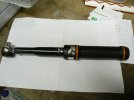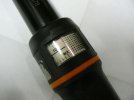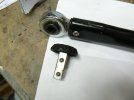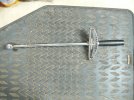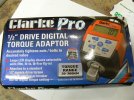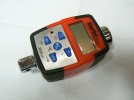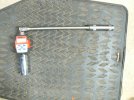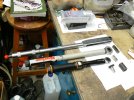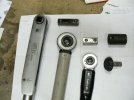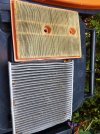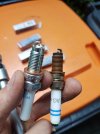I would agree with the above comments. Just buy the recommended plugs made by a "big name" manufacturer - eg. NGK, Bosch, etc - and buy from a trusted source like a motor trade supplier (Factor) or main dealer because there is a rampant trade in counterfeit motor spares, spark plugs in particular.
Choice of torque wrench? I really can speak with experience here having used torque wrenches for most of my working life. Don't buy a cheap "bargain". A torque wrench should be a precision instrument. I've used a lot of torque wrenches during my life and by using one you are often trying to set a fixing very precisely and close to it's point of failure. "Cheap" products, I can tell you, are unlikely to achieve this. The first one I bought was whilst I was still learning my trade back in the '60's and had to do the head gasket in my 850 Mini. There was a large trade parts supplier near me and he sold me a simple "beam type" wrench which did the job. As I got to know more about tools I quickly came to doubt this tool's accuracy and bought a Britool to replace it. The old beam wrench had a scale running from 0 to 150 ft lbs but, as with most torque wrenches, is probably only really accurate around it's mid range, which is actually why it probably got the Mini's nuts done up to around the correct tightness. I wouldn't particularly advise you buy this type as you have to watch the scale whilst you are using it and this can be difficult in some applications.
All my other wrenches are of the preset click type - except one, which I'll talk about later - I have 2 Britools with half inch drives one 25 to 135 nm range, the other 70 to 330 nm (for doing hub nuts, crank pulleys etc) I also bought a Norbar 30 to 150 nm as a back up to the smaller Britool. These tools have done me for many years but then, especially when metric fittings made their appearance, things started being held together with smaller nuts and bolts - 6mm studs (10mm spanner needed) on inlet manifolds suddenly started appearing whereas the older British cars would have used considerably larger items (1/2" AF spanner) so I found the torque settings were right at the lower end of what my wrenches could accurately do. After a lot of research I bought a Halfords Professional 3/8" drive with 8 to 60 nm range. I believe this is a rebranded Norbar wrench? I'm delighted with it - Not cheap but if you can get your hands on a Halfords trade card you'll get a serious discount on it. Ok, I know you're not in Britain, but others may benefit from this info. Some of the most accurate wrenches these days are based around strain gauge technology and have digital read outs but for a good one of these you are talking lots of cash. Also make sure you're chosen purchase can apply torque both clockwise and anticlockwise. many have a reversible square drive like the Britools and Norbar - I'll try to post an illustration at the end of this. You won't often need to torque left hand threads but it can be handy - I was working on an old Alfa Romeo a wee while ago which had right hand threaded wheel nuts on one side and left handed on the other!
One "left field" consideration might be a "Digital Torque Adaptor". This is a strain gauge type adaptor which has a female 1/2" drive on it's input side, to take some thing like a "T" handle or power bar, and a male 1/2" drive on the output side to accept a socket etc. You can set it in two modes. either you set up a preset figure you want to achieve and it will "beep" when that tightness is achieved - so, in this mode it's just like using a "click type" wrench except it "beeps" instead of "clicking". - Or you can set it up so it displays the tightness figure you are applying on it's wee display - so now it's like a beam type to use. I find it works very well indeed but it's bulky once you've got your drive bar on the one side and socket on the other, so pretty useless for doing cam belts etc, or anywhere that access is restricted. However it has one really great use for me, I use it to check calibration on my other mechanical type wrenches. This is because torque wrenches should be checked periodically for accuracy and recalibrated if necessary. This is not a cheap procedure but I find I can use the torque adaptor to check the other wrenches by setting the torque adaptor to record "live" figures as applied and presetting a click value on the wrench under test. Then I put my Lambda sensor socket in my vice and plug the adaptor into it with the torque wrench on top. Pull on the torque wrench whilst watching the adaptor figures as I go and see what I get when the wrench clicks. I do this for settings at about 1/4, 1/2 and 3/4 full scale on the wrench under test and repeat each 3 times to get an accurate figure. This allows me to quickly identify if one of my wrenches is going noticeably out of calibration. I've been in touch with the Clarke people about accuracy of the adaptor over time (ie does it, in itself, need to be periodically calibrated like a mechanical wrench) their reply was that possibly when it gets really old this might be advisable but as long as you use it sensibly and don't use it out of range, use good batteries and do the battery recalibration periodically (There is a function which needs to be done each time you use it which matches actual battery state to the adaptor - very simple to do - and there's a low battery warning too) They were very interested to hear I was using it in this way and could think of no reason why it would not give a valid outcome. So now I do this instead of spending a fair amount of money on regular, and often needless, recalibration charges.
I'll now attempt to post some images for you to illustrate the above. The black wrench is the 3/8 drive one and the silver one is my old beam deflection type.
Sorry, I did "go on" a bit there didn't I. But I hope it's all stuff which might
help you and anyone else thinking of buying one of these very useful and essential tools
Oh, and a wee PS here. VERY IMPORTANT - never leave a "click type" torque wrench with the spring wound up when you have finished using it. By which I mean you must wind it back down to the zero reading otherwise the spring will change it's characteristics (you might say it'll weaken) and from then on the calibrated scale becomes meaningless! Also keep it clean and
store it somewhere reasonably dust free. Dirt, even dust, in the working mechanism will alter it's accuracy.


